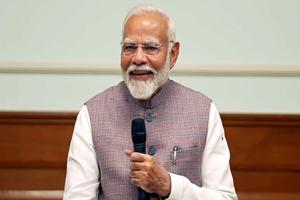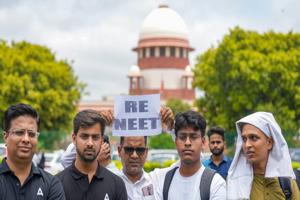
Insights IAS UPSC CURRENT AFFAIRS – 7 June 2024 covers important current affairs of the day, their backward linkages, their relevance for Prelims exam and MCQs on main articlesInstaLinks : Insta Links help you think beyond the current affairs issue and help you think multidimensionally to develop depth in your understanding of these issues. Table of ContentsGS Paper : 2 (UPSC CURRENT AFFAIRS – 7 June 2024)Women MPs in Lok Sabha Disparities in Education Outcomes in IndiaGS Paper 3: (UPSC CURRENT AFFAIRS – 7 June 2024)Issues with the Shift in Cropping PatternFacts for Prelims (FFP) (UPSC CURRENT AFFAIRS – 7 June 2024)Special Category Status (SCS) Clearing Corporation Reports in News Fungus Parengyodontium album Minuteman IIIMappingMount KanlaonUPSC CURRENT AFFAIRS – 7 June 2024Women MPs in Lok SabhaGS Paper 2Syllabus: Indian ParliamentSource: HTContext: The 18th Lok Sabha will have 74 women Members of Parliament (MP), a slight decrease from 2019 when 78 women were elected. The SCS States used to receive grants based on the Gadgil Mukherjee formula . Benefits of SCS States with SCS receive Centre-State funding from centrally sponsored schemes in a more favourable ratio of 90:10 compared to general category states. (UPSC CURRENT AFFAIRS – 7 June 2024) MappingMount KanlaonSource: TNIEContext: Mount Kanlaon, located in the central Philippines, erupted recently (through a Phreatic eruption) , prompting hundreds of people to seek shelter in evacuation centres.
Insights IAS UPSC CURRENT AFFAIRS – 7 June 2024 covers important current affairs of the day, their backward linkages, their relevance for Prelims exam and MCQs on main articles
InstaLinks : Insta Links help you think beyond the current affairs issue and help you think multidimensionally to develop depth in your understanding of these issues. These linkages provided in this ‘hint’ format help you frame possible questions in your mind that might arise(or an examiner might imagine) from each current event. InstaLinks also connect every issue to their static or theoretical background.
Table of Contents
GS Paper : 2 (UPSC CURRENT AFFAIRS – 7 June 2024)
Women MPs in Lok Sabha Disparities in Education Outcomes in India
GS Paper 3: (UPSC CURRENT AFFAIRS – 7 June 2024)
Issues with the Shift in Cropping Pattern
Facts for Prelims (FFP) (UPSC CURRENT AFFAIRS – 7 June 2024)
Special Category Status (SCS) Clearing Corporation Reports in News Fungus Parengyodontium album Minuteman III
Mapping
Mount Kanlaon
UPSC CURRENT AFFAIRS – 7 June 2024
Women MPs in Lok Sabha
GS Paper 2
Syllabus: Indian Parliament
Source: HT
Context: The 18th Lok Sabha will have 74 women Members of Parliament (MP), a slight decrease from 2019 when 78 women were elected.
Status of women in legislatures:
Women will now constitute 13.6% of the new Lok Sabha, down from 14.3% in the previous term . (although increasing from 5% in the first Lok Sabha ) India’s representation of women in the Lok Sabha, at 13. 63%, falls behind several other countries, with South Africa, the UK, and the US boasting higher percentages. In the 2024 elections, women MPs were elected from 14 parties , with the BJP leading with 31 MPs, followed by Congress with 13, and TMC with 11. Of the 74 women MPs elected, 43 are first-time MPs , and the average age is 50 years. Around 10% of candidates in the 2024 elections were women, marking an increase from previous years. Compared to other countries like Rwanda and Cuba , India’s representation of women in legislatures remains relatively low.
Reasons for low women representations:
Gender conditioning : Women may lack political ambition due to factors like less encouragement to run for office, self-doubt about qualifications, reluctance towards competition, fear of ‘big politics’, and family considerations. Patriarchal society: Gender disparities, sexual division of labour, cultural and social expectations, and illiteracy hinder women’s participation in politics. Gatekeepers : Party leaders may show bias in promoting male candidates over female candidates, affecting the selection process and hindering women’s chances of election. Lack of political education, growth in criminalization , and corruption further contribute to the underrepresentation of women in politics. Structural Disadvantages : Election campaigns are expensive, time-consuming, and fraught with issues like inappropriate commenting, hate speeches, abusive threats, and use of muscle power, which disproportionately affect women candidates.
Benefits of High Representation of Women in Legislature:
Focus on gender issues: Stronger attention to women’s concerns and implementation of women-sensitive policies. Gender equality: Essential for genuine democracy and ensuring women’s interests are on government agendas. Accountability : Direct engagement leads to better representation and accountability for women. Gender-sensitive governance : Promotes reforms for gender equality in public policy. Encourage inclusive initiatives : Supports programs and subsidies to enhance women’s decision-making. Change stereotypes: Collaboration with media to portray women as effective politicians, challenging stereotypes.
Steps Taken for Increasing Women’s Political Representation:
Nari Shakti Vandan Adhiniyam, 2023: Amends the Constitution to reserve one-third of seats in Lok Sabha and State Legislative Assemblies for women. Constitutional Amendments : The 73rd and 74th Amendments reserve one-third of seats in Panchayats and Municipalities for women. SDG Target 5.5 : India pledged to achieve women’s full and effective participation at all levels of decision-making in politics and public life. Constitutional Measures : Articles 14, 15, 46, and 243D ensure equality, protection against social injustice, and reservation of seats for women in Panchayati Raj Institutions. Legislative Initiatives : Establishment of the Parliamentary Committee on Empowerment of Women and gender-neutral rules in the Lok Sabha. International Commitments : Agreements such as the Convention on the Elimination of All Forms of Discrimination against Women and the Beijing Platform for Action emphasize enhancing women’s political representation globally.
Suggestions for Enhancing Women’s Representation in Legislatures:
Implement Quotas : Establish clear, well-structured regulations with effective enforcement mechanisms to increase female representation. Quotas can significantly boost women’s presence in parliament. Combat Violence : Address psychological and physical violence against women in politics by establishing cross-party working groups, developing policies to combat sexism and harassment, and creating a fair complaints system. Mentorship Programs: Provide mentorship opportunities for women politicians to connect with experienced counterparts, enabling them to gain valuable insights and leadership skills. Media Participation : Increase women’s participation in media by educating journalists, addressing bias, and monitoring press coverage to promote fair representation of women in politics. Women’s Caucuses: Support women’s parliamentary caucuses to foster gender equality legislation and policy agendas, amplifying women’s voices and influence in parliament.
Insta Links:
Disparities in Education Outcomes in India
GS Paper 2
Syllabus: Government Policies and Intervention
Source: LM
Context: National Achievement Survey (NAS) 2021 highlights the disparities in educational outcomes among Indian states, advocating for improved teaching methods and targeted interventions to enhance learning outcomes for all students.
What is NAS 2021 ?
NAS 2021 is a nationwide assessment conducted (by the Ministry of Education) to gauge the academic performance of students across India.
Findings:
Performance Decline: NAS 2021 shows a significant decline in student performance compared to NAS 2017. Class 3 scores dropped by 3. 9% in Language, 4.7 % in Mathematics, and 4.4% in Environmental Studies (EVS). Class 10 scores fell by 13.4% in Mathematics, 18.6% in Science, and 9.1% in Social Science. Disparities Across States : Some states like Punjab, Rajasthan, and Haryana perform well, while Meghalaya, Mizoram, Nagaland, and Chhattisgarh lag behind in educational outcomes. Performance Drop with Progression : Scores decline as students progress from Class 3 to Class 10. Language scores fell from 64. 6% in Class 3 to 52% in Class 10, and Mathematics scores dropped from 61.2% in Class 3 to 44% in Class 10. According to UNESCO, India has the highest number of children out of school globally , with an estimated 17 million children between the ages of 6-14 still out of school.
Reasons for the decline:
Inequality: Marginalized groups like Dalits and tribal communities face discrimination and lack opportunities compared to privileged students. A study by NCERT shows these students often experience abuse and mistreatment in schools. Shift in Assessment Style : The transition from rote learning to competency-based assessments poses challenges for students accustomed to traditional methods. Impact of COVID-19 Pandemic : Disruptions caused by the pandemic, including school closures and remote learning, have significantly contributed to learning setbacks. Inadequate Foundational Learning : Weak foundational skills in early grades result in difficulties that accumulate as students advance. Insufficient Reinforcement of Concepts : Lack of regular revisiting and reinforcement of core concepts, as per Bruner’s Spiral Curriculum Theory, leads to knowledge gaps as students progress.
Other Issues with Education in India:
Issues Description Education Sector Crisis Reckless commercialization and politicization have led to a crisis in the education sector, lacking a coherent strategy and focusing on quick-fix solutions like technology. Limits of Edutech Despite the hype around technology in education, start-ups like Byju’s have failed to deliver, highlighting the need for quality teachers’ over-reliance on technology . Preference for Tuition Centers Parents increasingly favour tuition centres over regular schools, contributing to mental health issues among students and furthering the educational divide. Quality Variance in Schools Disparities between public and private schools persist due to poorly trained teachers in government schools, neglecting efforts for quality improvement. Widening Educational Divide The gap between rich and poor students widens within a failing education system, underscoring the need for innovative teaching methods and greater societal involvement. Lack of Societal Involvement Education should be a societal concern, but there is a lack of community engagement and volunteerism , hindering efforts for meaningful change in the education sector. Insufficient Education Spending India’s education spending remains low , stagnating at 2.61% of GDP, far below the recommended 6% by the Education 2030 Framework for Action Political Leadership and Fiscal Imagination There is a lack of political commitment and imagination in allocating sufficient funds for education, hindering India’s potential for global leadership in the sector. Inadequate Infrastructure in Schools Many schools lack basic infrastructure like internet facilities , computers, furniture, electricity, ramps for the disabled, and proper WASH facilities, impacting the learning environment. High Dropout Rate NFHS-5: 21.4% of girls, and 35.7% of boys dropped out due to lack of interest in studies.
Legal and Constitutional Safeguards:
Suggestions for Improvement:
Experiential Learning Approach: Introduce problem-solving subjects for hands-on learning, and utilize Artificial Intelligence for experiential learning. Implementation of National Education Policy (NEP): Shift to a 5+3+3+4 system, ensuring uniformity across states. Education-Employment Corridor : Integrate vocational learning, and provide mentorship in government schools, especially in rural areas. Reducing the Language Barrier : Give equal importance to Indian languages, and establish special agencies for translation. Taking a Note From Past to Future : Learn from the ancient ‘Gurukul’ system, emphasize holistic development and values education, and adopt practical assessment methods.
Mains Link:
Q1. How have digital initiatives in India contributed to the functioning of the education system in the country? Elaborate on your answer. (UPSC 2020)
Q2. Discuss the main objectives of Population Education and point out the measures to achieve them in India in detail. (USPC 2021)
Prelims Link:
Which of the following provisions of the Constitution does India have a bearing on Education? (UPSC 2012) Directive Principles of State Policy Rural and Urban Local Bodies Fifth Schedule Sixth Schedule Seventh Schedule Select the correct answer using the codes given below: (a) 1 and 2 only
(b) 3, 4 and 5 only
(c) 1, 2 and 5 only
(d) 1, 2, 3, 4 and 5 Ans- (d)
Issues with the Shift in Cropping Pattern
GS Paper 3
Syllabus: Agriculture, Cropping Pattern, Geography
Source: BS
Context: Shift in paddy sowing may not aid despite normal monsoon, as groundwater depletion persists.
India anticipates a normal monsoon, enhancing agricultural output , yet groundwater depletion poses challenges. Punjab and Haryana’s wheat-paddy cycle exacerbates this issue, with paddy consuming significant water. Groundwater extractio n rates in these states surpass national averages, aggravating the situation.
What is a Cropping Pattern ?
Cropping pattern can be defined as the proportion of area under various crops at a point in time. In other words, it is a yearly sequence and spatial arrangement of sowing and fallowing in a given area. In India, the cropping pattern is determined by rainfall, climate, temperature, soil type and technology.
Change of cropping pattern in India
Cash crops : The crop pattern has changed with a very satisfactory trend, i.e. growing more cash crops like fruit and vegetables instead of food grains .
The crop pattern has changed with a very satisfactory trend, i.e. growing more cash crops like fruit and vegetables instead of food grains Shifted to horticulture : Since good inputs (seeds and know-how) are available, farmers are growing horticultural crops along with or as an alternative to food grains. India produces 10% of the world’s production of fruits and holds the first place in the case of fruits like papaya, mango, and banana, among others.
Since good inputs (seeds and know-how) are available, farmers are growing horticultural crops along with or as an alternative to food grains. Water intensive to water efficiency patterns : Some water intensive Food grains (paddy) and cash crops (such as sugarcane) losing interest in favour of water-efficient crops or pulses and oil seeds. These are not only water-efficient but also climate-resilient.
Some water intensive Food grains (paddy) and cash crops (such as sugarcane) losing interest in favour of water-efficient crops or pulses and oil seeds. Organic farming : Many regions of the country have also seen an increase in cropping area under organic farming. States like Sikkim have become fully organic states.
: Many regions of the country have also seen an increase in cropping area under organic farming. States like have become fully organic states. ZBNF: Many states like Maharastra, and Telangana are promoting Zero Budget Natural farming, under it use of chemicals for growing crops is discouraged.
The reason behind the change in the cropping pattern
Reason Details Nutrient deficiency in soil Continuous mono-cropping depletes soil nutrients, as exemplified by the rice-wheat system in Northwestern India. State laws Punjab and Haryana enacted the Punjab Preservation of Subsoil Water Act (PPSWA) and the Haryana Preservation of Subsoil Water Act (HPSWA ): They had an unintended consequence of increasing stubble burning and air pollution in northern India. Resource use efficiency Mono-cropping reduces resource efficiency; diversification revitalizes soil health. Urbanisation Population growth and urbanisation stress agricultural land, leading to intensified and commercial crop cultivation. Infrastructure facilities Improved irrigation, transport, and post-harvest handling allow farmers to diversify crops. Government incentives Programs like Paramparagat Krishi Vikas Yojana incentivize crop pattern changes. Erratic rainfall Unpredictable weather patterns force farmers to alter cropping strategies. Changing consumption patterns and market conditions Increasing demand for protein-rich foods has led to a rise in soybean cultivation, while the growing preference for meat and dairy has shifted focus to commercial fodder crops Market conditions, including a push for exports and the rise of food processing products, have influenced farmers’ choices towards high-value crops.
Significance of crop diversification
For farmers; It increases crop portfolio so that farmers are not dependent on a single crop to generate their income. Farmers who plant different kinds of crops are able to tap into their regional markets and contribute to strengthening their local economies . This helps farms thrive and provides them with greater financial security.
Government : Most of the Indian population suffers from malnutrition . Most of the girl children have anaemia. Including crops like pulses, oilseed, horticulture, and vegetable crops can improve socio-economic status by adding quality to the food basket ensuring food safety and nutritional security.
Most of the Indian population suffers from . Most of the girl children have anaemia. Including crops like pulses, oilseed, horticulture, and vegetable crops can improve socio-economic status by ensuring Environment ; – It makes farms more environmentally friendly. This is because planting a variety of crops makes the soil healthier, along with reducing chemical use .
It makes farms more environmentally friendly. This is because planting a variety of crops makes the . Disease resistance : The traditional way to grow crops is to plant a single cultivar in a given area. However, this results in entire fields that are susceptible to the same hazard, be it a pest or disease.
The traditional way to grow crops is to plant a single cultivar in a given area. However, this results in entire fields that are susceptible to the same hazard, be it Availability of water ;-it promotes efficient use of water thereby reducing the demand for water for irrigation purposes.
;-it promotes efficient use of water thereby reducing the demand for water for irrigation purposes. Trade; – India is one of the largest importers of pulses, oilseeds etc. and diversification of crops can potentially reduce India’s import dependence thereby reducing the burden on exchequer.
Conclusion
India, being a vast country of continental dimensions, presents wide variations in agroclimatic conditions. Such variations have led to the evolution of regional niches for various crops. Historically, regions were often associated with the crops in which they specialize for various agronomic, climatic, hydro-geological, and even, historical reasons.
But, in the aftermath of technological changes encompassing biochemical and irrigation technologies, the agronomic niches are undergoing significant changes.
Insta Links:
Mains Link:
Explain the changes in cropping patterns in India in the context of changes in consumption patterns and marketing conditions (UPSC 2023)
(UPSC CURRENT AFFAIRS – 7 June 2024) Facts for Prelims (FFP)
Special Category Status (SCS)
Source: TH
Context: The strong showing of Chandrababu Naidu’s Telugu Desam Party (TDP) and Nitish Kumar’s Janata Dal-United (JD(U)) in the 2024 Lok Sabha elections has reignited their calls for special category status (SCS) for their respective states, Andhra Pradesh and Bihar.
About SCS:
Special Category Status (SCS) Description About SCS Special Category Status (SCS) is a classification granted by the Centre to assist in the development of states facing geographical and socio-economic disadvantages. Introduced in 1969 on the recommendations of the Fifth Finance Commission , it was initially granted to Jammu & Kashmir, Assam, and Nagaland . Later, states like Sikkim and Tripura were also included. The SCS States used to receive grants based on the Gadgil Mukherjee formula . However, after the recommendations of the 14th Finance Commission, SCS was stopped for any new states. Current Status Currently, no new states have been granted SCS . Special funding patterns for North Eastern and Himalayan states are based on recommendations from a Sub-Group of Chief Ministers, not through SCS . Factors for SCS Before granting SCS to a state, five factors were considered: hilly and difficult terrain, low population density and/or significant tribal population, strategic location along international borders, economic and infrastructural backwardness, and non-viable nature of state finances. States with SCS Currently, 11 states in India have SCS : Arunachal Pradesh, Assam, Himachal Pradesh, Jammu and Kashmir, Manipur, Meghalaya, Mizoram, Nagaland, Sikkim, Tripura, and Uttarakhand. Benefits of SCS States with SCS receive Centre-State funding from centrally sponsored schemes in a more favourable ratio of 90:10 compared to general category states. They also enjoy tax concessions and exemptions to attract investment. Demand from Bihar and Andhra Pradesh Bihar and Andhra Pradesh have been demanding SCS. Bihar’s demand is based on its low per capita income and high poverty rates. Andhra Pradesh demands SCS due to revenue loss after the 2014 bifurcation , as promised by former Prime Minister Manmohan Singh.
Clearing Corporation
Source: ET
Context: SEBI forms a committee, chaired by Usha Thorat, to review the ownership and economic structure of clearing corporations.
Aim : Ensure resilience, independence, and neutrality. Previous norms by SEBI focused on dispersed ownership and governance framework . The current structure is dominated by parent exchanges, raising concerns about independence and capital infusion. Globally, major clearing corporations have diversified shareholding models.
What are CCs?
Clearing Corporations (CC) handle the clearing and settlement of trades in securities or other instruments traded on stock exchanges. They are integral to the financial market infrastructure, serving as central risk management institutions and first-line regulators.
CCs serve as central risk management institutions and play a regulatory role. The Securities Contracts (Regulation) (Stock Exchanges and Clearing Corporations) Regulations , 2018, outline the norms for the ownership and governance framework of CCs.
Reports in News
Reports Description A World of Debt Report 2024 The “A World of Debt Report 2024” by UN Trade and Development (UNCTAD) highlights a significant surge in global public debt, which reached a historic peak of $97 trillion in 2023 . India’s public debt reached $2.9 trillion in 2023 , amounting to 82.7% of its GDP. To address the current debt crisis, the report outlines several initiatives, including the Heavily Indebted Poor Countries (HIPC ) Initiative by the IMF and World Bank, the Debt Management and Financial Analysis System (DMFAS) programme by UNCTAD, and the Global Sovereign Debt Roundtable (GSDR), launched in February 2023 by the IMF in coordination with the World Bank and India’s G20 presidency. Global Annual to Decadal Climate Update (2024-2028) This annual report by the World Meteorological Organization (WMO) synthesizes global annual to decadal predictions. Key highlights include an 80% likelihood that the annual average global temperature will temporarily exceed 1.5°C above pre-industrial levels for at least one year between 2024-2028; Predicted reductions in sea-ice concentration in the Barents Sea, Bering Sea, and the Sea of Okhotsk. Environmental Performance Index (EPI), 2024 The Yale Center for Environmental Law & Policy recently published the EPI 2024, ranking 180 countries on climate change performance, environmental health, and ecosystem vitality using 58 indicators across 11 categories. Estonia tops the lis t. India is ranked 176th, being the world’s third-largest greenhouse gas emitter with a 32% increase in emissions over the past decade. In 2022, India surpassed China as the largest emitter of anthropogenic sulfur dioxide. Nature Geosciences projects study on Groundwater A study in Nature Geosciences projects a 2.1°C rise in groundwater temperature from 2000 to 2100 due to climate change. This warming reduces oxygen levels, causing hypoxic conditions that harm species growth and distribution, trigger harmful algal blooms, and impact food and reproductive cycles of temperature-sensitive species, threatening biodiversity. India has the largest area under groundwater irrigation globally .
Fungus Parengyodontium album
Source: Lab Equipment
Context: Recently, the marine fungus Parengyodontium album was discovered to break down oceanic polyethylene (PE) plastic.
About Parengyodontium album:
This fungus converts PE-derived carbon into fungal biomass, using it as an energy source, a process that requires the initial photodegradation of PE by UV sunlight. This discovery highlights the potential of P. album to degrade floating oceanic plastic litter .
With over 400 billion kilograms of plastic produced annually, much of which ends up in the ocean, researchers are optimistic that other plastic-degrading fungi may exist in the deeper parts of the ocean, given fungi’s reputation as “masters of degradation ” due to their diverse digestive enzymes.
Minuteman III
Source: Space Force
Context: The US conducted an unarmed Minuteman III intercontinental ballistic missile (ICBM) test from Vandenberg Space Force Base, California .
The LGM-30G Minuteman III, a solid-fueled ICBM first deployed by the USAF in the 1960s, serves as the sole land-based component of the U.S. nuclear triad. Designed and manufactured by Boeing , it was initially intended for a ten-year service life but has been continually modernized.
What are ICBMs ?
Intercontinental ballistic missiles (ICBMs) are long-range missiles capable of delivering nuclear warheads across continents . They are a key component of a nation’s nuclear deterrent strategy due to their ability to strike distant targets quickly. In India, examples of ICBMs include the Agni series, such as Agni-V , which has a range of over 5,000 kilometres, and Agni-VI, which is currently under development and is expected to have an even longer range.
(UPSC CURRENT AFFAIRS – 7 June 2024) Mapping
Mount Kanlaon
Source: TNIE
Context: Mount Kanlaon, located in the central Philippines, erupted recently (through a Phreatic eruption) , prompting hundreds of people to seek shelter in evacuation centres.
About Mount Kanlaon/ Canlaon:
It stands as the highest peak on Negros Island and is one of the active volcanoes within the Philippines’ Pacific Ring of Fire. The volcano comprises various pyroclastic cones and craters , with its summit boasting a broad caldera and a crater lake.
Phreatic eruptions, c haracterized by steam-driven explosions resulting from heated groundwater, are typical occurrences, often preceding or following traditional volcanic eruptions.
UPSC CURRENT AFFAIRS – 7 June 2024 [PDF]
Follow us on our Official TELEGRAM Channel HERE
Subscribe to Our Official YouTube Channel HERE
Please subscribe to Our podcast channel HERE
Official Facebook Page HERE
Follow our Twitter Account HERE
Follow our Instagram Account HERE
Follow us on LinkedIn: HERE
©All Rights Reserved.







